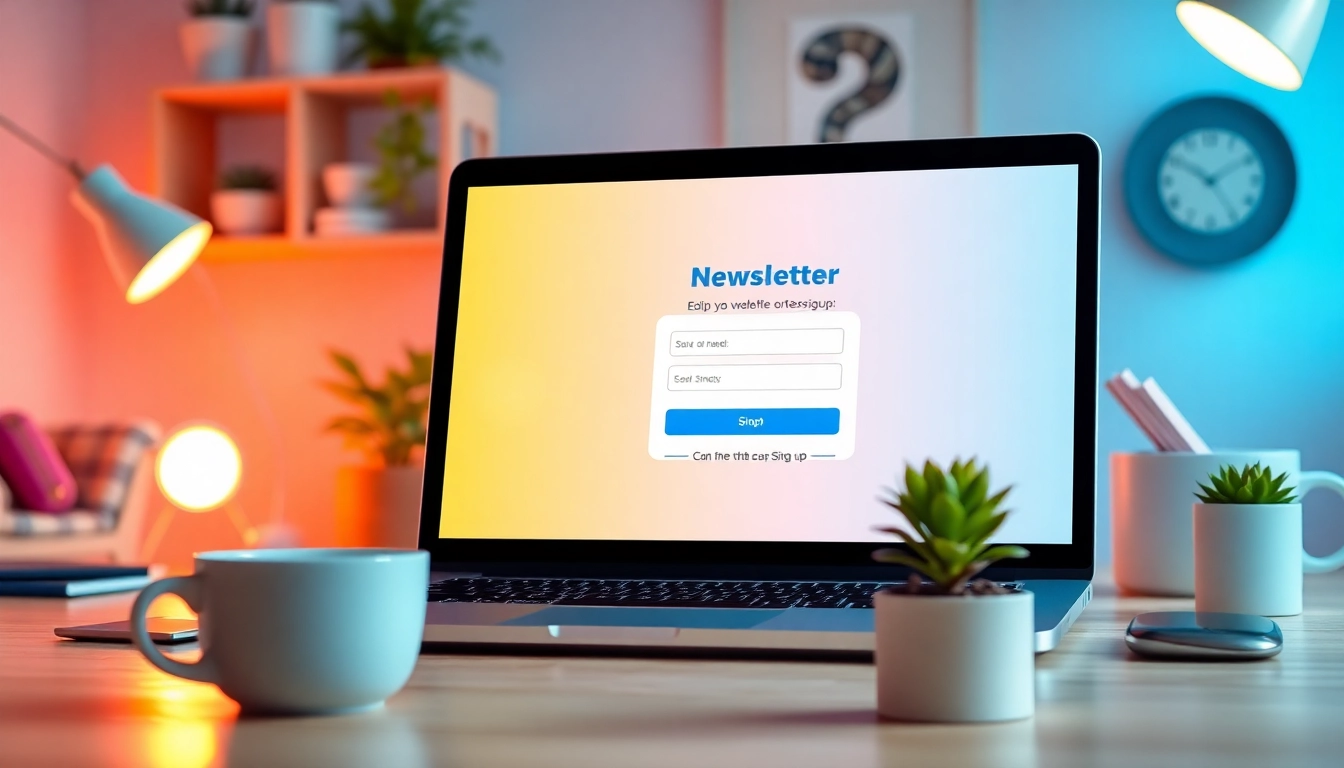Understanding the Importance of Newsletter Signup
In the rapidly evolving digital landscape, businesses must embrace effective communication strategies that foster strong relationships with their audience. One of the most impactful of these strategies is the newsletter signup, which provides a direct line of communication between brands and their customers. By encouraging newsletter signup, businesses can grow their audience, share valuable content, and ultimately drive sales.
What is a Newsletter Signup?
A newsletter signup is a prompt placed on a website or platform that invites visitors to subscribe to a newsletter. This may be in the form of a simple email input box or a more elaborate form with additional fields asking for user preferences. Once a user subscribes, they typically receive regular updates about company news, promotions, or content directly to their inbox, thus nurturing a continuous engagement.
Benefits of Growing Your Email List
The benefits of expanding your email list through newsletter signups are numerous:
- Direct Communication: Email gives you a direct path to your subscribers, free from the clutter of social media algorithms.
- Targeted Marketing: With segmenting, brands can target specific groups with tailored content that resonates with their interests.
- Cost-Effective: Email marketing is one of the most cost-effective strategies available, with a high return on investment.
- Increased Customer Loyalty: Regular updates keep your brand top-of-mind, fostering a sense of loyalty and community among subscribers.
- Measurable Results: Email analytics tools allow you to track open rates, click-through rates, and conversions, making it easier to optimize your strategy.
Common Challenges in Newsletter Signups
While many advantages come with effective newsletter signups, businesses often encounter several challenges:
- Visitor Resistance: Many users are cautious about sharing their email addresses, primarily due to privacy concerns.
- High Competition: With numerous brands vying for attention, standing out requires an appealing value proposition.
- Technical Issues: Implementing effective forms requires an understanding of various tools and platforms, which can be daunting for non-technical users.
- Lack of Content Strategy: Without a continuous stream of engaging content, even the most well-designed signup form may fail to convert.
Best Practices for Designing Newsletter Signup Forms
Designing an effective newsletter signup form is crucial for increasing conversions. The form must be user-friendly and strategically placed while clearly conveying value to potential subscribers.
Key Elements of an Effective Signup Form
Several key elements must be considered when designing an effective signup form:
- Simplicity: Keep the signup form as simple as possible. Limit the number of fields to the essentials—usually just name and email address.
- Clear Call-to-Action: Ensure your call-to-action (CTA) is compelling and clear. Phrases like “Join Our Community” or “Get Exclusive Offers” can be effective.
- Visible Design: Position the form prominently on your website, such as in the header, footer, or as a pop-up, making it easy for visitors to find.
- Privacy Assurance: Include a brief note about how you’ll protect subscribers’ information and what they can expect in terms of email content.
Placement and Timing Strategies
The placement and timing of your signup form significantly influence its effectiveness:
- Above the Fold: Placing the signup form above the fold ensures it’s one of the first things visitors see, increasing the likelihood of signups.
- After Engaging Content: Placing a signup form at the end of a valuable piece of content can capture visitors when they’re most engaged.
- Exit-Intent Pop-Ups: Use pop-ups that trigger when a visitor intends to leave the site. These can remind users of the value they’ll receive by subscribing.
- Mobile Optimization: Ensure the form is mobile-friendly, as a significant portion of website traffic comes from smartphones and tablets.
Incentives to Encourage Signups
Offering incentives can significantly boost signup rates. Here are some effective strategies:
- Exclusive Content: Providing access to exclusive articles, guides, or resources can entice users to subscribe.
- Discounts and Promotions: Discounts on services or products encourage immediate signup opportunities.
- Free Trials or Samples: For products, providing a free trial or sample can reduce the barrier to entry for new subscribers.
- Contests and Giveaways: Hosting a giveaway can drive interest and competition among your audience.
Examples of High-Performing Newsletter Signup Forms
Understanding how successful companies execute their newsletter signups can provide valuable insights. Here are a few case studies and examples:
Case Studies from Various Industries
Examining how different industries approach newsletter signups can reveal unique tactics:
- E-commerce Brands: Many successful e-commerce sites use eye-catching sign-up forms that offer discounts on first purchases, proving to be an effective way to increase both signups and conversions.
- Media Outlets: News organizations like The New York Times wisely segment their newsletters based on user interests, ensuring that the content they send is relevant and engaging.
- Non-Profit Organizations: Non-profits often provide potential subscribers with stories of real impact, encouraging emotional connections that lead to signups.
Learning from Successful Brands
Two notable brands that excel at newsletter signups include:
- Dropbox: Offers free storage space in exchange for an email signup, demonstrating the effectiveness of practical incentives.
- BuzzFeed: Utilizes humor and relatable content in their sign-up prompts, making the process enjoyable for users.
Visual Design Inspiration
The visual design of your signup form plays a crucial role in attracting subscribers. Here are key considerations:
- Color Psychology: Use colors that align with your brand’s identity and evoke the desired emotional responses.
- Whitespace: Ensure there is ample whitespace around your signup form to draw attention and avoid clutter.
- User Experience Testing: Conduct A/B testing to assess which designs and layouts yield the highest signup rates.
Integrating Signup Forms into Your Website
Once you’ve designed your newsletter signup form, it’s essential to integrate it seamlessly into your website. Here’s how:
Choosing the Right Platform
Select the right email marketing platform that aligns with your needs. Some popular options include MailChimp, Constant Contact, and HubSpot. Consider factors such as:
- Integration Capabilities: Ensure the platform integrates well with your current website and other tools.
- Analytics Tools: Choose a platform that offers advanced analytics to track key performance metrics.
- User-Friendly Interface: A straightforward interface can save time during both setup and ongoing maintenance.
Technical Considerations for Implementation
Implementation accuracy is vital. Here are several technical considerations to keep in mind:
- GDPR Compliance: Ensure your forms comply with regulations like GDPR for data protection and privacy.
- Mobile Responsiveness: Test the forms on various devices to guarantee a seamless signup experience.
- Verification Process: Implement a double opt-in process to confirm user interest and maintain a quality mailing list.
Monitoring Signup Performance Metrics
Once integrated, monitor performance metrics to gauge effectiveness:
- Signup Rate: Measure the percentage of visitors who complete the signup form versus total visitors.
- Conversion Rates: Analyze how many subscribers take desired actions post-signup, like making a purchase.
- Engagement Levels: Track open and click-through rates to understand how recipients interact with your newsletters.
Future Trends in Email Newsletters and Signups
The world of email newsletters is always changing, influenced by new technologies and evolving user expectations. Here’s a look at some future trends:
Emerging Technologies for Signup Forms
Technological advancements are reshaping how businesses collect email addresses:
- AI and Machine Learning: Tools that can analyze user behavior will help in optimizing the timing and placement of signup forms.
- Interactive Forms: Engaging forms that use visual media, like video or animated graphics, are likely to become more popular.
Adaptation to User Expectations
As consumers become increasingly aware of privacy and personalization, businesses must adapt:
- Transparency: Providing clarity on data usage and privacy will be vital in gaining user trust.
- Personalization: Tailoring content based on user preferences will enhance engagement and drive conversions.
The Role of Personalization in Engagement
Personalization remains a top priority for successful email marketing strategies:
- Targeted Messaging: Subscribing to newsletters should feel like an exclusive insider experience rather than a generic broadcast.
- Dynamic Content: Utilizing tools that allow for dynamic content based on subscriber data can elevate the user experience.



